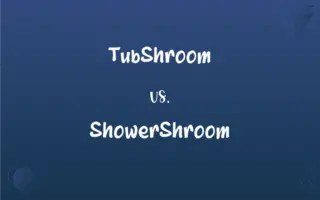Seeds vs. Pits: What's the Difference?
Edited by Aimie Carlson || By Janet White || Published on February 26, 2024
Seeds are reproductive units of plants, small and capable of growing into new plants. Pits are large, hard seeds or stones inside certain fruits, like peaches.

Key Differences
Seeds are the small, embryonic plants enclosed in a protective outer covering, essential for the reproduction of many plant species. Pits, often referred to as stones, are large, hard seeds found inside certain fruits like peaches and cherries, surrounded by a fleshy fruit part.
Seeds can vary greatly in size and shape, from tiny poppy seeds to larger ones like beans, and are often capable of being planted and grown. Pits, however, are typically not planted due to their hard, protective shell that surrounds the seed inside, making them less accessible for planting.
The function of seeds is to propagate the species, containing nutrients for the seedling until it can photosynthesize on its own. Pits serve a similar reproductive function, but their hard casing protects the seed inside from damage and from being eaten by animals.
Seeds are often dispersed in various ways, including wind, animals, and water, facilitating widespread plant growth. Pits are usually dispersed through animal consumption and excretion, relying on animals to transport the seed away from the parent plant.
In terms of human consumption, seeds are often eaten and used in cooking, like sunflower or pumpkin seeds. Pits are generally not eaten due to their hardness and size, but the fruits enclosing them are consumed.
ADVERTISEMENT
Comparison Chart
Size and Structure
Small, various sizes and shapes
Large, hard, typically encased in fruit
Plantability
Often planted to grow new plants
Less commonly planted due to hard casing
Function
Reproduction and species propagation
Protect the seed and aid in reproduction
Dispersal Method
Wind, animals, water
Animal consumption and excretion
Human Consumption
Commonly eaten, used in cooking
Not typically eaten, but the fruit is
ADVERTISEMENT
Seeds and Pits Definitions
Seeds
The reproductive unit of a plant, capable of developing into another plant.
She planted tomato seeds in her garden.
Pits
The central part of some fruits, often discarded in cooking.
When making avocado toast, you have to remove and discard the pit first.
Seeds
An item used in agriculture and gardening for growing plants.
They bought various seeds for their spring planting.
Pits
Serves to protect the seed inside and aid in its dispersal.
The pit helps the seed inside survive the digestive tract of animals.
Seeds
A small embryonic plant enclosed in a covering.
The seeds in the apple can grow into new apple trees.
Pits
The hard, protective casing around the seed of certain fruits.
He carefully removed the pit from the peach before eating it.
Seeds
A source of nourishment for the seedling as it grows.
The seeds contained enough nutrients to sustain the young plants.
Pits
Not typically consumed due to its hardness and size.
The apricot pit is too hard to eat, unlike the fruit.
Seeds
Often dispersed by natural forces for plant propagation.
The dandelion seeds were carried away by the wind.
Pits
A large seed found in the center of fruits like cherries and plums.
Cherry pits must be discarded before making jam.
Seeds
A mature plant ovule containing an embryo.
Pits
A natural or artificial hole or cavity in the ground.
Pits
An excavation for the removal of mineral deposits; a mine.
FAQs
How do seeds disperse?
Seeds can be dispersed by wind, water, animals, or other natural means.
Are pits edible?
Generally, pits are not edible due to their hardness and size.
Can you eat seeds?
Many seeds, like sunflower or pumpkin seeds, are edible and nutritious.
What are seeds?
Seeds are the plant's reproductive units, capable of growing into new plants.
What fruits have pits?
Fruits like peaches, cherries, plums, and apricots have pits.
What is a pit in botany?
A pit is the large, hard seed found inside certain fruits like peaches and cherries.
How do pits help in plant reproduction?
Pits protect the seed inside and are often dispersed by animals, aiding in plant reproduction.
What's the difference between seedless and seeded fruits?
Seedless fruits lack developed seeds, while seeded fruits contain fully formed seeds.
Can you plant a fruit pit?
While possible, pits often require special preparation to germinate.
Do seeds need soil to grow?
Most seeds need soil, water, and sunlight to germinate and grow.
Are pits harmful to animals?
Some pits can be harmful if swallowed due to choking hazards or toxicity.
Are all seeds small in size?
Seed sizes vary greatly, from tiny like poppy seeds to larger ones like avocado seeds.
How are seeds harvested?
Seeds are harvested from the mature fruit or seed pod of the plant.
Do seeds contain nutrients?
Seeds contain nutrients to support the growth of the new plant.
Why are some pits poisonous?
Some pits contain substances like cyanide, which can be toxic.
Do all plants produce seeds?
Most plants reproduce through seeds, but some use other methods like spores.
What's the best way to remove pits from fruit?
It depends on the fruit, but often cutting around the pit or using a specialized tool works best.
Can seeds be used for cooking?
Yes, many seeds are used in cooking and as a source of oil.
Is it safe to compost pits?
Pits can be composted but take longer to break down than other organic materials.
Can you grow a tree from a pit?
It's possible, but it requires the right conditions and preparation.
About Author
Written by
Janet WhiteJanet White has been an esteemed writer and blogger for Difference Wiki. Holding a Master's degree in Science and Medical Journalism from the prestigious Boston University, she has consistently demonstrated her expertise and passion for her field. When she's not immersed in her work, Janet relishes her time exercising, delving into a good book, and cherishing moments with friends and family.
Edited by
Aimie CarlsonAimie Carlson, holding a master's degree in English literature, is a fervent English language enthusiast. She lends her writing talents to Difference Wiki, a prominent website that specializes in comparisons, offering readers insightful analyses that both captivate and inform.






































































